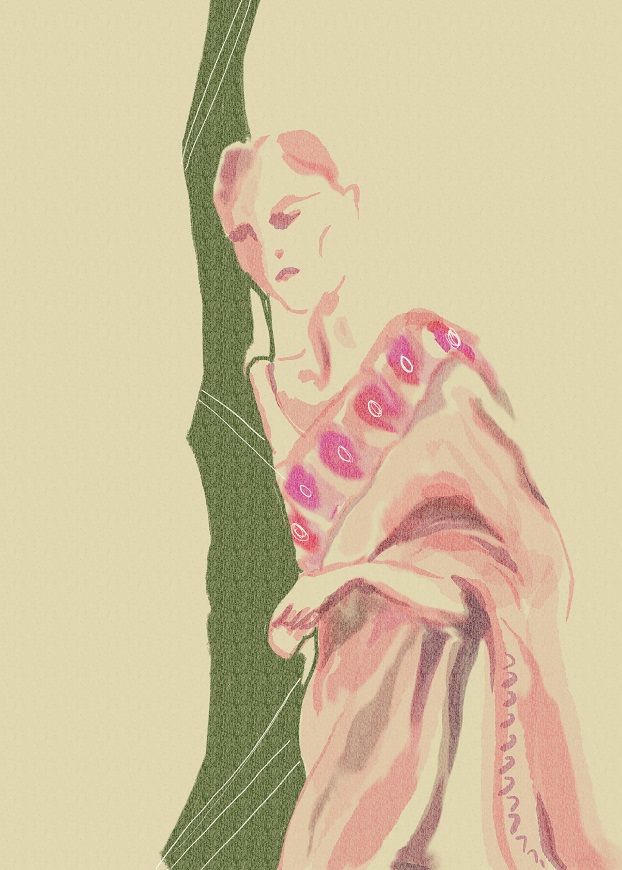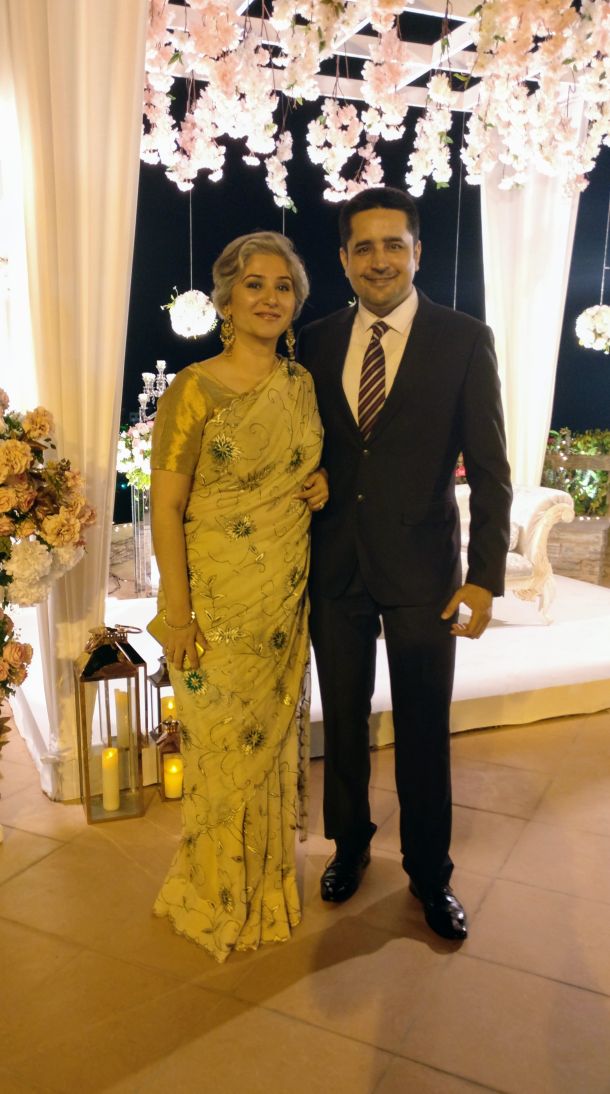
How the drape holds meaning and memory for the desi mind, body, and soul. A series of interview-vignettes, showcasing uber serious sari love, brought out via passion, history, politics, through interviews with people across the spectrum who love to drape it, and also, talk about it! Catch up with Chapter One’s interview with impassioned crafts activist Laila Tyabji, Chapter Two’s chat with filmmakers Shabani Hassanwalia and Paromita Vohra, Chapter Three‘s Sari Sisters Jaya and Swaati, and Chapter Four’s focus on politics in the pleats with Sabika and Jasmine. Chapter Five shared a special chat with writer Anuja Chauhan, and Chapter Six a post in the voice of Himanshu Verma, aka Saree Man. Millennial musings featured in Chapter Seven, and two lyrical storytellers unfolded the “memory wrap” of the sari in the penultimate Chapter Eight.
* * *
Power. Politics. Pakistan. Panache. The sari diva concluding this special series packs a punch with all of the above, and more.
My Karachi sister Afia Aslam, co-founder of Desi Writers’ Lounge, offers food for thought, as she unfolds memory snapshots that are both personal and political, and for those of us in India, powerful notes from the other side reminding us once again, how it was once this side.

Pooja Pande (PP): When was the first time you wore a sari? Is this a distinct memory?
Afia Aslam (AA): The first time I remember wearing a sari was at a family dinner at my uncle’s place in Karachi. I was a teenager at the time, and we were visiting from Islamabad. It was a purple and pink sari with a floral design. I can’t quite remember the cloth, but I do recall that it was synthetic — no pure silks etc. for me at the time! The blouse was also a plain purple synthetic silk, its short sleeves vigorously pressed and creased as if it was a shirt.
I was super pleased with how the sari was looking, but to be honest it was a bit of an overkill at a small family dinner, particularly for a teenager wearing it for the first time! I remember my uncle thought it was a little strange, and of course his wife immediately stepped in to compliment me because … well, let’s just say, these are the times men really need wives to cover for them!
PP: Sari stories are only a close second to food stories, right?
AA: No, I don’t agree with that. Food would definitely win (the pulao you used to have in your mother’s house, the mangoes you would have at your nani’s table etc.). I think desi culture is quite strongly rooted in eating (this food for that religious festival, the culture of cooking at home, the expectation that you’ll get fresh bread with every meal!) and I also think that desis tend to be very attached to a nostalgic idea of home and community, so the shared food experience really plugs into that.
PP: Which sari-wearing personality did you idolize, while growing up?
AA: My nani used to look very imposing in her crisp, silk saris. My khala (mother’s sister, technically her cousin) used to wear cotton saris to work, and was known for them, as she was the only one who used to do that at her school. People still mention that when they ask about her: “How is Mrs. Rabbani? She used to wear saris all the time, didn’t she? She used to stand out.”
But the person who I think I really adored growing up (which is as close as I can come to the real emotion of having idolized someone), was my grandfather’s sister from Delhi. I still remember with absolute clarity the moment that I first met her. It was her first visit to Pakistan. I knew that his sister was coming, and he was excited about it, but nothing prepared me for what I was about to experience. I should clarify that my grandfather’s sister was an absolute powerhouse of aura and charm — I have actually not met anyone else since who had that kind of magnetism.
So, it was not just about the sari; let’s just say the sari really helped in completing the impression she made as she swept in through that door. It was a simple, white cotton sari, and her salt and pepper hair was open, lying loosely on her shoulders, and she was smiling that smile that permeated every bit of her. The air in the room changed with her presence. I remember literally staring at her with my mouth open, which probably wouldn’t have made the best first impression on someone else — but then, she wasn’t anyone else. We stayed friends, writing letters to each other until she passed away several years later. What a woman.
PP: Has your relationship with the sari and sari-wearing changed over the years?
AA: Oh, yes. In the early years, my mother would tie my saris for me, and I would pin the palloo to the blouse at my shoulder, and I was worried that the sari would unravel and “fall off”. One of the things I’ve enjoyed most about saris is having grown comfortable in them as I’ve grown older. No more pin at the shoulder, no more self-consciousness at whether my tummy is spilling out a bit over the petticoat, certainly no more asking Amma to tie my sari for me!
After deciding at 39 to stop dyeing my hair, this dynamic has evolved further. I’ve always gotten compliments in saris, but a head of silver hair gives an edginess to the sari look, and a different quality to the compliments. I’ve enjoyed that.
I don’t wear saris that often anymore, though, which makes me sad. Somehow the motherhood and home-maker grind was easier to manage in shalwar qamees, and saris became a once a year wedding outfit thing. I recently gave away one of my cotton saris from Bangladesh to a friend, in the hope that she’ll give it the love it deserves.
PP: Do you consider the sari formal wear?
AA: The sari is certainly associated with formal wear in Pakistan, and that’s because it’s rarely worn here, so it is saved by most people for a special occasion. And then, because they don’t really know how to tie it, they get the folds pre-stitched from their tailors. That’s usually the time I’ll give them a lecture on authentic sari etiquette!
PP: How would you describe the previous generations’ relationships with the saris, as compared to yours?
AA: I would say that my grandparents’ generation was far more comfortable in saris, and knew how to tie and carry them. You would never see their saris hitched above their heels, for instance. There was also a simpler, more classic aesthetic. My generation and those after me have a different concept of it: once-in-a-while wear, more emphasis on machine embroidered fabric, modern blouses (I recently purchased a black and silver, sleeveless tank top from a store to use as a sari blouse).
PP: Why and how did the sari land up as one of the sites of political charcha, in your opinion?
AA: For Pakistan, the sari became politicized during General Zia’s era, when word went out that army wives should stop wearing this Indian outfit. That idea of the sari being an Indian symbol spilled over, of course, and so for quite a while it was complicated to wear a sari (your patriotism could easily be brought into question). It took ages for that stigma to pass. I think the internationalization of Bollywood and Indian culture had a lot to do with it: the sari became something much bigger than just Indian, and the sari itself evolved significantly in terms of styles and looks, and so perhaps it became easier to digest at some level.
PP: What stops you from wearing a sari today, if anything?
AA: Convenience. It’s just easier for me to make the school run in jeans or a shalwar qamees. It’s easier to put those items away after use also. The second biggest hindrance is that all my blouses are old, and I have … er … grown! I will literally need to get new blouses made for everything. Just the thought tires me out!
PP: Which is your current favorite sari, Afia?
AA: One of my mother’s jahaiz saris, which is off-white chiffon handworked with gold and emerald green floral embroidery. It’s my go-to wedding sari since the last few years … it’s the only one I had a new blouse made for!
PP: Do you think there are as many sari styles as there are sari wearers?
AA: I’ve never really looked at it that way … I suppose a sari will fall differently on everyone’s body, so perhaps it would be correct to say that each person’s sari look becomes just their own. I do think it’s a very special way of underlining one’s femininity, and the power of that femininity. A sari is a sari is a sari: it always makes a statement.
* * *
Pooja Pande is a writer-editor who grew up in, considers home, and hence has a suitably complex love-hate relationship with the capital city of India, Delhi. Her first book is Red Lipstick, a literary-styled memoir on celebrity transgender rights activist Laxminarayan Tripathi. Find her on Twitter at @derrindo.












